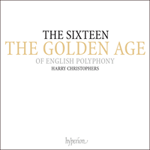Eterne laudis lilium is almost certainly the ‘Anthem of oure lady and Saint Elisabeth’ for which Fayrfax was paid 20 shillings by Elizabeth of York, wife of Henry VII, on 28 March 1502. The proof of this connection with royalty lies in the text which, as well as being a highly fanciful genealogy of Jesus Christ down the female line, is an acrostic which spells out the name of its dedicatee. There are perhaps more ‘redundant notes’ in the composition of this piece than elsewhere, suggesting an earlier work than
Maria plena virtute, especially in the full sections, but there are touches of genius which are well known—the taking up of Elizabeth’s name, for example, by all the voices, in a ground-breaking compositional gesture—or the ‘Amen’, surely the most beautiful example of through-composed imitative writing from anyone in this period.
from notes by Peter Phillips © 2024
Eterne laudis lilium était très probablement l’«Anthem of oure lady and Saint Elisabeth» pour laquelle Fayrfax fut payé 20 shillings par Elizabeth d’York, épouse d’Henry VII, le 28 mars 1502. La preuve de cette relation avec la royauté se trouve dans le texte qui, tout en retraçant une généalogie très fantaisiste de Jésus-Christ par la lignée féminine, est un acrostiche qui épelle le nom de sa dédicataire. Il y a peut-être davantage de «notes superflues» dans la composition de cette pièce qu’ailleurs, ce qui laisse supposer qu’il s’agit d’une œuvre antérieure à
Maria plena virtute, surtout dans les sections à plein effectif, mais il y a des touches de génie qui sont célèbres—par exemple, le fait de confier le nom d’Elizabeth à toutes les voix dans un geste de composition révolutionnaire—ou l’«Amen», sûrement le plus bel exemple d’écriture imitative entièrement composée jamais écrite à cette époque.
extrait des notes rédigées par Peter Phillips © 2024
Français: Marie-Stella Pâris
Dabei handelt
Eterne laudis lilium sich mit ziemlicher Sicherheit um das „Anthem of oure lady and Saint Elisabeth“, wofür Fayrfax am 28. März 1502 von Elisabeth von York, der Gemahlin Heinrichs VII., 20 Schillinge erhielt. Der Beweis für diese Verbindung mit dem Königshaus findet sich im Text, in dem nicht nur eine höchst phantasievolle Abstammung Jesu Christi über die mütterliche Linie dargelegt wird, sondern sich auch ein Akrostichon findet, mit dem der Name der Widmungsträgerin buchstabiert wird. In diesem Werk gibt es vielleicht mehr „überflüssige Töne“ als anderswo, was darauf hindeutet, dass es ein früheres Werk als
Maria plena virtute sein könnte, insbesondere in den vollstimmigen Abschnitten, doch es finden sich auch geniale Einfälle, die wohlbekannt sind—etwa das Aufgreifen von Elisabeths Namen in allen Stimmen in einer hochoriginellen kompositorischen Geste, oder das „Amen“, sicherlich das schönste Beispiel für durchkomponierte imitatorische Komposition überhaupt aus dieser Zeit.
aus dem Begleittext von Peter Phillips © 2024
Deutsch: Viola Scheffel


 Fayrfax: Maria plena virtute & other votive antiphons
Fayrfax: Maria plena virtute & other votive antiphons The Sixteen & The Golden Age of English Polyphony
The Sixteen & The Golden Age of English Polyphony
